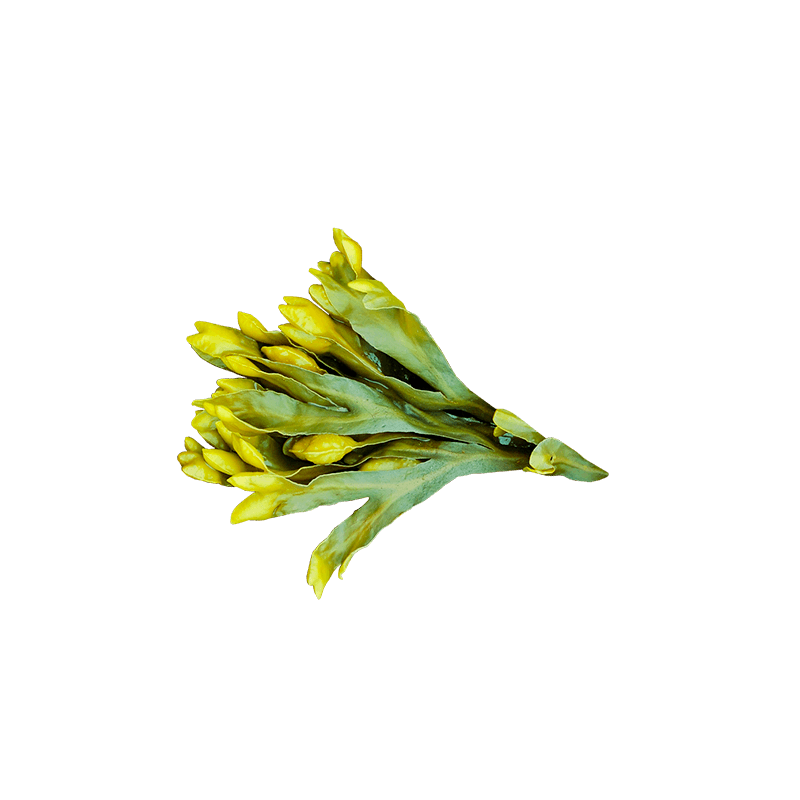
Bladder wrack
Latin name
Origin
Used part
Active components
Polyphenols (phlorotannins): antioxidants that also have antibiotic, antifungal and anti-inflammatory properties.
Minerals (such as potassium, magnesium, calcium and iron): essential for good health.
Iodine: stimulates the metabolism because it is an essential nutrient for the thyroid.
Mucilages: have a soothing effect and are an interesting component for cosmetics.They also have a laxative action.
Carotenes (fucoxanthin): an antioxidant with a slimming action.
Usage
Asian populations consume algae as a food in different forms: raw in a salad, as a vegetable, a condiment or in a sweet jelly but also cooked in a soup. Bladder wrack is used as a phytotherapeutic agent in cosmetics, treatments for coughs, asthma, haemorrhoids, goitre, stomach ache, certain urinary conditions, ulcers and headaches. It can help women with irregular menstrual cycles. Bladder wrack is known to promote digestion and stimulate transit by acting as a binding agent. It has a stimulating effect on the metabolism of energy.1-11 It acts as an appetite suppressant and has a slimming effect and can be used to help control and maintain body weight.9-12
Bibliographical references
- Effects of kelp supplementation on thyroid function in euthyroid subjects.
Clark CD, Bassett B, Burge MR.
Endocr Pract. 2003 Sep-Oct;9(5):363-9.
Pubmed: http://www.ncbi.nlm.nih.gov/pubmed/14583417 - J Clin Endocrinol Metab. 1998 Oct;83(10):3398-400.
What's happening to our iodine?
Dunn JT.
The Journal of Clinical Endrocronology & Metabolism: http://jcem.endojournals.org/content/83/10/3398.long - Iodine: Deficiency and Therapeutic Considerations
Lyn Patrick, ND
Alternative Medicine Review Volume 13, Number 2 2008
http://www.thorne.com/altmedrev/.fulltext/13/2/116.pdf - Antioxidant Capacities of Phlorotannins Extracted from the Brown Algae Fucus vesiculosus.
Wang T, Jónsdóttir R, Liu H, Gu L, Kristinsson HG, Raghavan S, Olafsdóttir G.
J Agric Food Chem. 2012 Jun 5.
Pubmed: http://www.ncbi.nlm.nih.gov/pubmed/22612266 - Phlorotannins from brown algae (Fucus vesiculosus) inhibited the formation of advanced glycation endproducts by scavenging reactive carbonyls.
Liu H, Gu L.
J Agric Food Chem. 2012 Feb 8;60(5):1326-34.
Pubmed: http://www.ncbi.nlm.nih.gov/pubmed/22248148 - Dietary fiber and antioxidant capacity in Fucus vesiculosus products.
Díaz-Rubio ME, Pérez-Jiménez J, Saura-Calixto F.
Int J Food Sci Nutr. 2009;60 Suppl 2:23-34.
Pubmed: http://www.ncbi.nlm.nih.gov/pubmed/18951280 - Antioxidant activities of sulfated polysaccharides from brown and red seaweeds.
Rocha de Souza MC, Marques CT, Guerra Dore CM, Ferreira da Silva FR, Oliveira Rocha HA, Leite EL.
J Appl Phycol. 2007 Apr;19(2):153-160.
Pubmed: http://www.ncbi.nlm.nih.gov/pubmed/19396353 - Potential antioxidant capacity of sulfated polysaccharides from the edible marine brown seaweed Fucus vesiculosus.
Rupérez P, Ahrazem O, Leal JA.
J Agric Food Chem. 2002 Feb 13;50(4):840-5.
Pubmed: http://www.ncbi.nlm.nih.gov/pubmed/11829654 - Dietary combination of fucoxanthin and fish oil attenuates the weight gain of white adipose tissue and decreases blood glucose in obese/diabetic KK-Ay mice.
Maeda H, Hosokawa M, Sashima T, Miyashita K
J Agric Food Chem. 2007 Sep 19;55(19):7701-6.
Pubmed: http://www.ncbi.nlm.nih.gov/pubmed/17715888 - Fucoxanthin and its metabolite, fucoxanthinol, suppress adipocyte differentiation in 3T3-L1 cells.
Maeda H, Hosokawa M, Sashima T, Takahashi N, Kawada T, Miyashita K.
Int J Mol Med. 2006 Jul;18(1):147-52.
Pubmed: http://www.ncbi.nlm.nih.gov/pubmed/16786166 - Fucoxanthin from edible seaweed, Undaria pinnatifida, shows antiobesity effect through UCP1 expression in white adipose tissues.
Maeda H, Hosokawa M, Sashima T, Funayama K, Miyashita K.
Biochem Biophys Res Commun. 2005 Jul 1;332(2):392-7.
Pubmed: http://www.ncbi.nlm.nih.gov/pubmed/15896707 - Seaweed carotenoid, fucoxanthin, as a multi-functional nutrient.
Maeda H, Tsukui T, Sashima T, Hosokawa M, Miyashita K.
Asia Pac J Clin Nutr. 2008;17 Suppl 1:196-9.
Pubmed: http://www.ncbi.nlm.nih.gov/pubmed/18296336
The health claims that feature on our website in relation to the plants contained in our products are compliant with the list of health claims awaiting final assessment by the Community authorities (cf. website of the European Commission: http://ec.europa.eu/nuhclaims/). However, they may be subject to modification following their assessment by the national competent authorities.
The health claims relating to other nutrients or substances contained in our products that feature on our site are compliant with Regulation No. 432/2012 of the Commission of 16 May 2012 which establishes a list of authorised health claims authorised in relation to food products, other than those in reference to the reduction of the risk of disease as well as community-based development and child health (cf. website of the European Commission: http://ec.europa.eu/nuhclaims/).

 Belgique
Belgique  België
België  France
France  Italia
Italia  Portugal
Portugal  España
España  United Kingdom
United Kingdom  Κύπρος
Κύπρος 